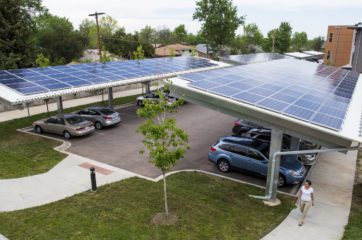After months of public hearings and deliberations, Oregon lawmakers released the highly-anticipated, amended version of the state’s landmark cap-and-trade bill.
Sen. Michael Dembrow (D) and Rep. Karin Power (D), the co-chairs of the Joint Committee on Carbon Reduction, released the revamped, 130-page amendment package on March 25th in hopes it will appease the various interests that lobbied against it. Environmentalists expressed concern that exemptions were given to too many polluters, while industries worried the program would increase costs and result in job loss.
The cap-and-trade plan, known as Clean Energy Jobs, follows California’s Western Climate Initiative, in requiring the state’s largest polluters to purchase credits, known as “allowances,” for every ton of pollution they emit. This cap decreases over time to ensure the state complies with its emission reduction goals, and revenue is invested in climate initiatives and transportation projects.
What’s New?
Key changes, largely based on testimony from citizens and industry players, were unveiled by lawmakers on Monday. Sen. Dembrow and Rep. Power said as legislators reworked the legislation, they took into account common concerns expressed throughout seven public hearings across the state.
The result? A package that addresses the needs of rural communities, acknowledges the limitations of available technologies, ensures major polluters previously exempt are regulated. Here are the most crucial changes:
1. Rebates for Rural Oregonians
The proposed package returns all fuel-related revenue to residents that make less than the state’s median income. This system will help lessen the burden of increased gas prices on rural communities.
The refund will work out to about 33 cents per day, which is the estimated cost gas hikes will have on rural Oregonians. The refunds, expected to total around $100 million annually, will consume about a fifth of the cap-and-trade program’s overall revenues. The remaining $400 million will be invested in a variety of climate initiatives and transportation programs.
The revised bill does not specify exactly how refunds will be administered, but does create a Climate Action Refund program designed to oversee the process.
2. New Allocation Scheme
Under the previous bill, certain industries were slated to receive 100% free credits in the first year of the program. Each year after, they were to receive a gradually-decreasing amount in line with annual cap reductions.
The new allowance scheme is more complex, and more uncertain. Facilities will receive 95% free credits for the first three years. Every subsequent year, they will be allocated free credits at a rate equal to 95% of their expected output based on the “best available technology” in their industry, so that facilities relying on more outdated and inefficient technology will have to pay more. That way, companies will be financially incentivized to adopt less emission-intensive technology.
Prior to this change, companies had complained they were not being rewarded for implementing best practices in the absence of a cap-and-trade program, Powers said.
It’s unclear, however, exactly how this “best available technology” metric will be defined, and the state only plans to update technology standards every six years.
“If you’re really truly doing what’s best in class, you’ll be getting allowances to reflect that investment,” Powers said. “And if you’re not, you have an incentive to move to that quickly.”
3. More Specific Investment Requirements
The new bill prescribes more specific percentages for revenue investment. At least half of all funds must benefit rural low-income communities, and 10% is designated for and federally recognized Indian tribes. Revenue is also allocated to wildfire prevention and green jobs training programs.
It also provides more clarity on how revenue designated for transportation projects will be spent, something that public hearing testifiers repeatedly asked for. Grants will be distributed equally between state and local projects, with consideration given to the balance between greenhouse gas reduction and climate adaptation programs. Transportation investments must also be made in an equitable way, though the bill does not specify how this can be ensured.
4. Less Exemptions for Polluters
In response to environmentalists’ concern that too many industries were exempt from regulations, lawmakers removed exemptions for semiconductor makers, like Intel, and the particularly-harmful garbage-burning facility, Covanta Marion. The proposal now fully regulates emissions from waste incinerators and fluorinated gas.
“We heard a common thread that people felt that industry was getting a number of exemptions while regular people were not,” Rep. Power said.
Renew Oregon, the environmental coalition actively lobbying for the program, supports the new proposal.
“Oregonians of all ages across the state are calling for bold climate action. Our legislators have put in an enormous amount of work shaping a policy with input from communities and interests across the state,” Tera Hurst, the group’s Executive Director, said in a statement. “These amendments address many concerns our coalition had and, taken as a whole, this represents the kind of major action needed to transform Oregon to a clean energy economy.
What’s unchanged?
Though several aspects of the bill were significantly reworked, the most fundamental components of the legislation remain the same.
The emission cap gradually declines, requiring a 45% drop from 1990 emission levels by 2035 and an 80% drop by 2050. Polluters emitting more than 25,000 tons of carbon annually are required to buy allowances.
Similar to California’s cap-and-trade program and the Regional Greenhouse Gas Initiative, Oregon’s program allows entities to purchase offset credits in order to comply with reduction requirements. Offset projects must be real, permanent, quantifiable, verifiable and enforceable, and entities cannot fulfill more than 8% of their obligations through the purchase of offsets.
Emission allowances for natural gas utilities also stayed the same, at least for now. Under the most recent proposal, natural gas companies still receive free permits for only the portion of their total emissions that serve low-income customers. Their power counterparts, however, will receive free allowances for 100% of their estimated emissions through 2030. Sen. Dembrow said lawmakers are in the process of discussing a compromise with the natural gas sector.
What’s next?
More negotiations and proposals are expected in the coming weeks. But there certainly is a high political opportunity for carbon pricing in Oregon, and Sen. Dembrow said he’s aiming to pass the bill within the next few weeks. If enacted, the Clean Energy Jobs bill will make Oregon just the second US state to establish an economy-wide cap on greenhouse gas emissions. More states will likely follow.









